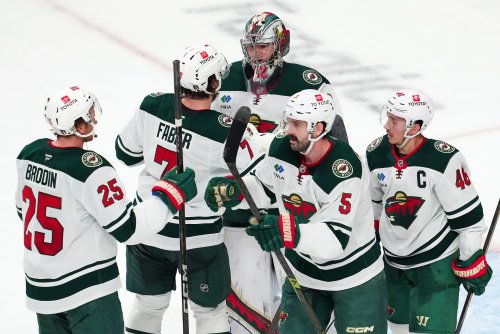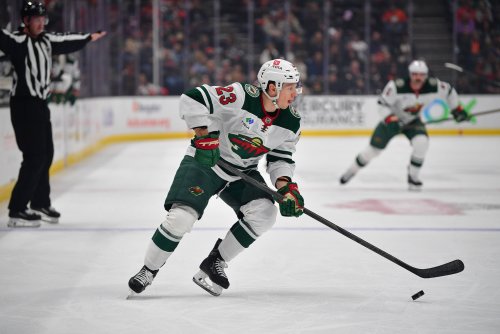
The Minnesota Wild are six days away from their first National Hockey League game since March 8. In that time the world has changed. The standard rota in the news has shifted to topics and numbers that would have seemed impossible this time last year. Everything has simultaneously slowed down to the hours spent in our homes, and sped up as the news updates, sometimes by the hour, seem like a crashing waterfall, overwhelming and never-ending. Coupled with that has been the fear and anxiety around all facets of life, especially around the unknowns for returning to some sense of normalcy in the near future.
Since the start of quarantine in March, pundits, researchers, and just about everyone else have talked about the toll exacted by the COVID-19 pandemic on mental health. For the first time, mental health has been a national concern and received the attention and discourse it has deserved for far too long. Among the discussion (and flood of resources provided by the WHO, the CDC, and other institutions) has been the dual-edged sword of sports factoring into the collective stress most people are experiencing.
On the one side is the desire for sports to return. Since the 19th century, sports have been an escape — a way to forget all the worries crowding in. Attending those early baseball games, filled with fights and wild runs, was a release from the brewing socio-political issues of the late 19th and early 20th century. In the latter half of the century, baseball (having outgrown its rebellious phase) was a soothing escape with the hours spent at the ballpark more about unwinding with loved ones over too-expensive beers and booing questionable calls by the umpires. Hockey had a similar trajectory, though less about relaxation after the goon squad era. Watching hockey games, whether at home or in the arena, were about the adrenaline rush, cheering until you were hoarse. All worries and stress forgotten and erased by the pure joy of frantically rooting your team to victory.
Sports have always offered that escape, no matter which sport, which country, or which era. In the wake of elections, national and natural disasters and senseless violence, sports have been the balm for a large portion of society. In sports there is hope and despair, community and found family, camaraderie and rivalry, purpose and irreverence. Sports are the blueprint of humanity, the best and worst of our culture packed into just a few hours, uniting people unlike just about anything else on the planet. They offer a source of inspiration for athletes (aspiring and pro) and spectators alike, no matter the situation. They offer hope and a way forward when the path seems dark. And they often lead the way with cultural change, showing fans everywhere the steps to progress that can be applied everywhere. Not just on the field, court, pitch, or ice.
At a time when it has felt as if the world were slowly crumbling to pieces, sports disappeared in a matter of 24 hours, leaving a gaping hole for many where they would have sought that escape, that hope, that relief. Anyone with an ounce of sense knew the pause was coming, but that didn’t make it any less visceral when it happened. The falling dominoes of league after league announcing a suspension in play felt like a nightmare all its own, somehow separate yet interwoven into the waking nightmare of the pandemic. Within a matter of days, many on Twitter and other social media platforms wished fervently for sports, for that escape, as the rising numbers coming out of Europe choked off all possibility of a quick return to normalcy. Yet there were no live sports, and the absence deepened, painful and sharp, as international tournaments — including the 2020 Summer Olympics and UEFA Euro 2020 — were postponed until 2021.
I was definitely among those fans who wanted nothing more than to turn on the television and pull up a live game of hockey or switch on a radio play-by-play of a spring training game. It felt wrong, mentally twitching every few days as if something was missing. And something was missing. The routine of live-tweeting several hockey games per week, editing game recaps before publication, settling in for a long lunch listening to the Cubs’ radio team sharing stories from Mesa during a Cactus League game, hyperventilating about the Raptors defending their title. All of that was missing. This season, I had also been a billet parent for the local WHL team, so the routine in my home of pre- and post-game meals, laughing over their stories from practice, the warm happiness watching them blossom into wonderful young men, all of that disappeared within a few days of major league sports hitting the pause button. March was ... not fun, to put it mildly.
I would have given just about anything to watch a live sporting event. Replays just weren’t the same, despite putting them on several nights a week during the regular season. Perhaps the worst of it all was the sudden, sharp epiphany that a very, very large portion of my daily schedule, of my life and my emotional investment was based around sports. It wasn’t an easy realization to sit with, especially when I couldn’t escape to a coffee shop or a bookstore to get out of my head. There was a creeping horror, a fear voicing over and over in my head, “What if sports never come back?”
That’s about the time I stopped craving sports coming back. In the past year, sports have been my work and my escape, between my work here at SB Nation, being a hockey billet mom, and curling up with highlights after intensive physical therapy sessions post-knee surgery. The light bulb about my love mixed with obsession for hockey led me to some reflection that was honestly needed, but that I had been constantly putting off with excuses of “in the offseason” and “when there’s a quiet moment in the news cycle” (good luck with that one).
Through the first few months of quarantine, the lack of sports to fill my time led me back to my roots. Three hundred pages of fiction written between April and the end of June. Planning out my cactus garden slowly taking shape in one corner of my front yard. Reading 26 books and a frankly ridiculous amount of Captain America comics. Devouring the stack of foreign and domestic policy and political history books, lectures, and podcasts I had been laying by for the offseason. (Top recommendations are Madeleine Albright’s memoirs, Pod Save America and Lovett or Leave It for podcasts, and “War on Peace” by Ronan Farrow.) Yes, sports were and still are a very large part of my life and my identity, but quarantine gave me the silver lining of making time again for all the other facets of who I am away from the sounds of sticks and skates on the ice. And it was needed.
In the past year, battling a grueling knee injury and two subsequent surgeries (the last — and thankfully final one — only six weeks ago) left me with not a lot of bandwidth. It was far too easy to bury myself in hockey as a reprieve. Instead of an escape and distraction, writing about hockey, talking about hockey, watching hockey is what always had been for me — pure and delighted fun. I’m ready for hockey to come back, to cheer and groan and dive deep on analytics as the Wild face the Vancouver Canucks in the qualification round. I’m so ready.
But here’s the thing — the world isn’t ready for hockey to come back. And that’s the other side of the double-edged sword of anxiety and fear around sports that we, as a collective, are experiencing. As much as we all want sports back, want to see our favorite players having fun and making impossible plays, we also want them to remain safe. In Europe and the United Kingdom, soccer has made a comeback. The league-wide positive case count for COVID-19 for those leagues remains a fraction of the 40-plus positive results the NHL has already tallied since the beginning of June. Part of that success is due to the changes the leagues made for distancing between players when not on the pitch and setting out strict distancing guidelines away from the team facilities. The NHL’s guidelines for Phase 3 look almost laughable in comparison, and the decision to enforce a bubble only in Phase 4 is even more ludicrous.
It’s all too easy to forget that these professional athletes, superstars and fourth-line grinders alike are people too, with families and retirement plans and lives to enjoy away from the rink and long after the pandemic has subsided. But then again, it’s even easier to remember that players like Luke Kunin (type 1 diabetes) and Steven Stamkos (history of blood clot concerns) stand to lose the most from a risky, early return-to-play plan. The research around COVID-19 shows the long-term issues and concerns for people diagnosed with the virus who make a recovery. Those that are disproportionally affected by the long-term issues include people with other health risks, such as diabetes, blood clots, and asthma. Many players have voiced their concern about returning to play without a vaccine available. And in other leagues, we’ve seen reports of players choosing to sit out the abbreviated 2020 season to stay safe in the hope of a vaccine-aided, semi-normal 2021 season.
Other players have chosen to play and voiced their reasoning for doing so. At the end of the day, hockey players are just like us. They just want some sense of normalcy back in what has been, frankly, the strangest year thus far. That decision and reasoning is valid, and will hopefully be backed by those players taking every precaution to protect themselves, their loved ones, and their teammates. And the players choosing to stay home are just as valid in their decision. After all, we’re all human and each of us has to cope with the pandemic-induced fear and anxiety as best as we can.
For some, that is being excited to see hockey returning. For others, that’s stepping away from sports, either as a spectator or player, to play the long game — staying safe for future seasons. It’s completely okay to experience one or both of those as we see more footage from the Wild practicing in the coming days. It’s also okay to feel conflicted about your reaction to hockey (and other major league sports) returning in the midst of the second wave of COVID-19 in the States. And it’s okay to take care of yourself as you experience all of this uncertainty and worry, whether that’s through binging all the exhibition games like it’s day one of the Olympics, distracting yourself with something else (such as gardening or binging “The Last Dance” on Netflix), or talking all of this out with the people you love. This is an extraordinary moment in human history, and I have no doubt we will make it out the other side. In the meantime, those “pregame” jitters you’re feeling are normal. We’re all feeling them. It means we’re human. And someday, hopefully in the not too distant future when we’re able to safely pack into rinks for games, we can look back at this moment and cherish the sports we love all the more for having got through this.
Think you could write a story like this? Hockey Wilderness wants you to develop your voice, find an audience, and we'll pay you to do it. Just fill out this form.








Recommended Comments
There are no comments to display.
Join the conversation
You can post now and register later. If you have an account, sign in now to post with your account.
Note: Your post will require moderator approval before it will be visible.